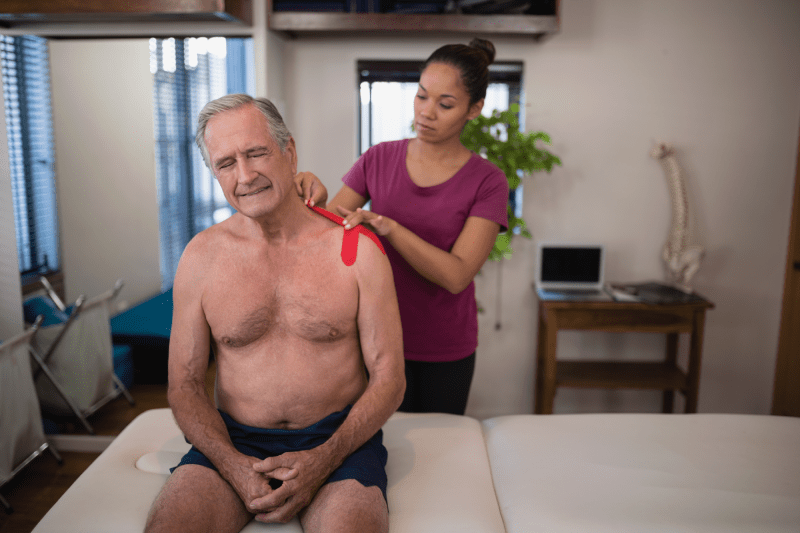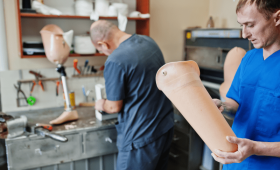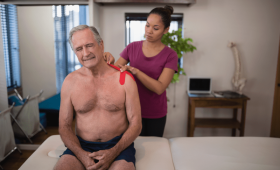What is Robotic-Arm Assisted Joint Replacement Surgery?
Robotic-arm assisted joint replacement surgery is an advanced technology method in which the surgeon performs the joint prosthesis implantation with the precise guidance of a robotic system. This system creates a three-dimensional model of the patient’s joint before the surgery.
Using this model, the surgeon plans the most ideal position and angle for the prosthesis with millimeter-level precision. During the surgery, the robotic arm helps the surgeon perform bone cuts and prosthesis placement with the highest level of precision by ensuring the surgeon works within the planned boundaries. This method aims to provide more controlled and predictable results compared to traditional surgery.
How is Robotic Surgery Different from the Traditional Method?
The main difference between robotic surgery and the traditional method is the tools and support system the surgeon uses during the operation. While in traditional surgery the surgeon works entirely with their own experience and manual skills, in robotic surgery, the robotic arm acts as a navigation system for the surgeon. This allows bone cuts and prosthesis positioning to be performed with a precision that the human hand cannot achieve. This millimeter-level precision extends the life of the prosthesis and reduces the risk of potential post-operative complications.
What Are the Advantages of Robotic-Arm Assisted Surgery?
The biggest advantage of robotic-arm assisted surgery is the placement of the prosthesis with the highest precision. This extends the life of the prosthesis and reduces risks such as loosening and dislocation. Additionally, the three-dimensional planning capability of the robotic system allows the surgeon to see all the details before the surgery. This enables the surgery to be completed with smaller incisions and less tissue damage. As a result, patients feel less pain, experience less blood loss, and their recovery process is faster.
In Which Joints Can Robotic Surgery Be Applied?
Robotic-arm assisted surgical systems are widely used in hip and knee joint replacement surgeries. These systems are specifically designed to optimize prosthesis placement in the complex anatomical structures of these joints. Thanks to the precision provided by robotic technology, surgeons can ideally position the prosthesis in the hip and knee joints and better meet the patient’s functional expectations. With the development of technology, its use in other joints like the shoulder and ankle is also becoming more common.
What Are the Benefits of Robotic Surgery in Knee Replacement?
In knee replacement surgery, robotic surgery ensures that the prosthesis is aligned most accurately with the leg axis. Since the knee joint has a complex anatomical structure, correct alignment is vital for the life of the prosthesis and the patient’s walking function. The precise bone cuts provided by the robotic system guarantee this alignment. Additionally, thanks to minimal tissue damage, post-operative pain is less, the hospital stay is shorter, and physical therapy can be started earlier.
What Are the Benefits of Robotic Surgery in Hip Replacement?
In hip replacement surgery, robotic surgery ensures that the ball and socket prostheses are placed at the correct angles and depths. This minimizes the risk of post-operative hip dislocation. Furthermore, the risk of leg length inequality is significantly reduced thanks to the millimeter-level measurements of the robotic system. Pre-operative three-dimensional planning helps the surgeon choose the most suitable prosthesis size and achieve the best results. Thanks to the minimally invasive approach, the patient recovers faster and returns to their daily life sooner.
Who is a Suitable Candidate for Robotic Surgery?
Robotic surgery is suitable for patients who need a joint prosthesis due to advanced joint osteoarthritis, post-traumatic arthritis, rheumatoid arthritis, and other joint diseases. Especially young patients with a more active lifestyle can benefit more from this method due to the extended life of the prosthesis and faster recovery. However, since every patient’s condition is different, it is best to make this decision based on the surgeon’s detailed examination and evaluation.

What is the Pre-Surgery Preparation Process Like for Robotic Surgery?
The pre-operative process begins in a similar way to traditional surgeries. Standard check-ups such as blood tests, an ECG, and a chest X-ray are performed to evaluate the patient’s overall health. Unique to robotic surgery, a three-dimensional CT or MR scan of the joint is taken before the surgery. These images are uploaded to the system to create the three-dimensional model that will be used in surgical planning.
Does Robotic Surgery Take Longer Than Traditional Surgery?
The duration of robotic surgery is generally a little longer than traditional surgery. The main reason for this is the detailed three-dimensional planning done before the surgery and the setup and adjustment stages of the robotic system during the operation. However, this extra time serves to perform the surgery with millimeter-level precision and reduce potential complications, which is much more beneficial for the patient in the long run. The total duration of the surgery varies depending on the patient’s condition and the surgeon’s experience.
How is Pain Managed After Robotic Surgery?
Pain after robotic surgery is generally less than with the traditional method because smaller incisions and less tissue damage occur. In the first few days after surgery, intravenous pain relievers are given to control the pain. Upon discharge, oral pain relievers are prescribed. Applying ice is also recommended to reduce pain and swelling. Most patients report that their pain significantly decreases within the first few days after surgery.
How Long is the Hospital Stay?
The length of the hospital stay after robotic surgery is generally shorter than with traditional surgery. Thanks to the minimally invasive nature of the surgery and faster recovery, patients can usually be discharged within 1 to 3 days. However, this duration can vary depending on factors such as the patient’s general health, age, and recovery speed. A quick discharge allows the patient to have a more comfortable recovery process at home.
When Does Physical Therapy Begin and How Long Does It Last?
The time to start physical therapy can be the day after the surgery. The minimally invasive nature of robotic surgery allows patients to mobilize earlier. The physical therapy program aims to help the patient regain joint range of motion and muscle strength and generally lasts for 3 to 6 months. Regular exercises with a physical therapist during the recovery process are vital for the long-term success of the surgery.
Does the Prosthesis Last Longer After Robotic Surgery?
Since robotic surgery places the prosthesis in the most suitable anatomical position with millimeter-level precision, it is thought that the prosthesis life is longer compared to traditional surgery. The correct positioning of the prosthesis reduces the risk of wear and loosening. This extends the life of the prosthesis and allows the patient to use a joint prosthesis without problems for a longer time. However, the prosthesis life also depends on the patient’s lifestyle, activity level, and weight control.
What Are the Risks of Robotic Surgery?
As with any surgical procedure, robotic surgery carries some risks. These risks include infection, bleeding, nerve damage, prosthesis dislocation or loosening. However, thanks to the high precision and pre-planning offered by the robotic system, these risks are lower compared to traditional surgery. Your surgeon will share all potential risks and complications with you in detail before the surgery.
Can Leg Length Inequality Be Prevented with Robotic Surgery?
Leg length inequality is a potential complication of hip replacement surgery. However, robotic surgery offers the possibility to adjust leg length and joint offset with millimeter-level precision according to the patient’s anatomical structure before the surgery. Thanks to this detailed planning, the surgeon minimizes the risk of leg length inequality and aims to achieve the best result after the surgery.
Is Robotic Surgery More Expensive?
Robotic surgery is generally more costly than traditional surgery due to the robotic system used and technology licensing fees. However, this cost difference can be balanced by indirect benefits such as a shorter hospital stay after the surgery, a faster return to work, and a reduced risk of revision surgery in the long run. In Turkey, these costs can vary depending on the hospital and city.
What Hospitals Perform Robotic Surgery in Turkey?
Many private hospitals in Turkey, especially in major cities, have invested in robotic-arm assisted joint replacement surgery technology. These hospitals aim to provide high-quality service to patients by following the latest innovations in modern medicine. When choosing a hospital, it is recommended that you thoroughly research the experience and references of the relevant surgeon and hospital in the field of robotic surgery.
Why is it Appealing to Get Robotic Surgery in Turkey?
Turkey has become a popular international destination for robotic-arm assisted joint replacement surgery. The most important reasons for this appeal include expert and experienced surgeons, modern hospitals with world-class technology, and more affordable costs compared to other countries. Additionally, the comprehensive rehabilitation services offered after the surgery are an important factor for patients choosing Turkey.
How Long is the Recovery Process to Normal Life?
The process of returning to normal life after surgery varies depending on the patient’s overall health, age, and the extent of the surgery. Thanks to robotic surgery, patients generally recover faster and can return to their daily activities sooner. It is possible to return to light office work within a few weeks, while for more physically demanding jobs, it may be necessary to wait for 3 to 6 months. Your surgeon and physical therapist will help you manage this process.
How Should Post-Surgery Nutrition Be?
Balanced and healthy nutrition is of great importance in supporting the post-operative recovery process. High-protein foods (chicken, fish, eggs) help with muscle and tissue repair, while foods rich in calcium and Vitamin D (dairy products, green leafy vegetables) support bone health. Furthermore, adequate water intake is also of vital importance during the post-operative period. The use of alcohol and tobacco should be avoided.

What Should Be Paid Attention to After Surgery?
After the surgery, it is important to follow some rules to extend the life of the prosthesis and prevent complications. You should strictly adhere to the exercise program recommended by your surgeon and physical therapist, avoid sudden movements that would strain the hip, and be careful against trauma such as falling from a height. Additionally, you should not skip regular doctor check-ups to monitor the condition of the prosthesis. Movements like squatting and crossing your legs should be avoided in the first few months.
Does the Risk of Revision Surgery Decrease After Robotic Surgery?
Since robotic surgery allows for the initial placement of the prosthesis with millimeter-level precision, it reduces the risk of conditions that may require revision surgery, such as prosthesis loosening. The correct positioning of the prosthesis increases joint stability and reduces the risk of wear, which in turn extends the long-term life of the prosthesis. This situation also potentially reduces the need for revision surgery.
How Can the Best Robotic Surgeon Be Found?
To find the best robotic surgeon, you should first research surgeons who specialize in orthopedics and traumatology, particularly those with experience in robotic-assisted joint surgery. It is important to get information about the number of robotic surgeries the surgeon has performed before and their success rates, and to read patient reviews. A reliable surgeon will patiently answer your questions and inform you in detail about all stages of the surgery.
Why is Losing Weight Before Surgery Important?
Excess weight can be a risk factor for the surgery itself and can shorten the life of the prosthesis by increasing the load on it. Reaching an ideal weight before the surgery reduces the risks of anesthesia and surgery. After the surgery, since the pressure on the prosthesis is reduced, a more comfortable and pain-free recovery process is experienced. Weight control is of critical importance for the long-term success of the surgery.
Why is Quitting Smoking Important?
Smoking slows down tissue healing by reducing blood flow in the body. Smoking before and after surgery delays wound healing, increases the risk of infection, and raises the risks of general anesthesia. Therefore, quitting smoking at least a few weeks before the surgery is vital for a successful surgery and a quick recovery process. Your surgeon will support you in this matter.
When Can I Drive After Surgery?
The time to start driving after surgery can be around 6 to 8 weeks. This period depends on whether the operated leg is on the right or left side and the patient’s recovery speed. It is best to start driving after you have stopped using support devices and are sure that you can safely press the brake pedal. Your physical therapist will give you specific advice on this.
Is Robotic Surgery Safe?
Robotic surgery is one of the safest methods used in joint replacement surgery. It offers a level of precision that the human hand cannot achieve during the planning and implementation of the surgery. The surgeon’s full control over the robotic system minimizes the risks. Studies show that robotic surgery offers lower complication rates and better long-term results. However, like any surgery, robotic surgery also has risks.
What is the Importance of Physical Therapy After Surgery?
Physical therapy plays a vital role in the success of the surgery. Regular and correct exercises after the surgery strengthen the muscles around the new prosthesis, increase the joint’s mobility, and help the patient return to their daily activities more quickly. Strict adherence to the physiotherapy program extends the life of the prosthesis and prevents potential complications.
Why is a Pre-operative CT Scan Necessary?
A pre-operative computed tomography (CT) or magnetic resonance (MR) scan is necessary for the robotic surgery system to create a three-dimensional model of the patient’s joint. This model allows the surgeon to plan the most suitable size, type, and location for the prosthesis with millimeter-level precision. During the surgery, this plan serves as a guide for the robotic arm to make the correct bone cuts. This technology helps the surgeon achieve more accurate and predictable results.
Robotic Da Vinci Replacement Surgeries in Turkey
The concept of a robot performing surgery may sound like something out of a science fiction movie, but robots are becoming more popular in operating rooms. Robots can help enhance precision in certain types of joint replacement surgeries, which can lead to better patient outcomes.
If you’re having surgery, you may be asking if robotic-assisted surgery in Turkey is only for specific types of patients. Robotic joint replacement is for you if you’re an excellent candidate for joint replacement surgery in general.
Who Performs Robotic Assisted Joint Replacement Surgery in Turkey?
The surgeon employs robotics to assist with the procedure. The robotic system does not operate on its own, make decisions, or move.
In the operating room, the licensed orthopedic surgeon remains the hands-on expert and decision maker. During the procedure, the robotic arm guides the incision position but remains under the surgeon’s supervision.
In the hands of a good surgeon, robotic-arm assisted technology is a tremendous instrument.
For superior results, the SmartRobotics System integrates three distinct components: haptic technology, 3-D visualization, and sophisticated data analytics.
The surgeon directs the robotic arm to solely target the injured joint. Mako’s AccuStopTM haptic technology provides surgeons with real-time visual, aural, and tactile vibration feedback, allowing them to “feel” the surgery and avoid ligament and soft-tissue damage that is common during surgical procedures. The surgeon can use haptic technology to direct the robotic arm to only the injured area of the joint.
Furthermore, the technology allows the surgeon to overlay the surgical plan on the joint during the procedure, allowing for adjustments to ensure that the implant is appropriately balanced within the preplanned bounds.
Is Robotics Joint Replacement Surgery a good fit for you?
Ask your surgeon if you are a candidate for robotic-assisted joint replacement surgery if you have joint discomfort that impairs your ability to move or perform daily activities. If you have degenerative osteoarthritis, rheumatoid or post-traumatic arthritis, avascular necrosis, or moderate joint abnormalities, you may be a candidate for a Robotic System joint replacement in Turkey.
• You have discomfort and stiffness that makes it difficult to do simple things like stand up from a seated position.
• You’ve tried nonsurgical, nonconservative therapies but they’re no longer working to relieve your pain or suffering.
• You are in good physical condition.
• You don’t have a pre-existing medical condition that necessitates a stay in a typical hospital.
When medicine and other non-surgical therapies have failed, it may be time to consider surgery.
Is Robotics Surgery Really Better?
Robotic joint surgery appears to have advantages over non-robotic operations, according to a growing body of evidence. However, data regarding all types of joint replacements is still being collected.
For a long time, surgeons have used robots in partial knee replacements. There is evidence to suggest that robotic partial knee replacements have fewer failures than traditional partial knee replacements.
Only lately has the technology been developed for use in total knee and hip replacements.
Contact us to get more information about Da vinci replacement surgery costs in Turkey.



